Fairbanks Morse to Power US Navy Warship LHA-9
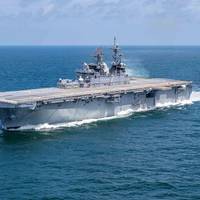
Power solutions provider Fairbanks Morse announced Tuesday that it will supply the ship service diesel generator (SSDG) sets for the electric power generation system aboard the U.S. Navy’s newest America class amphibious assault warship LHA-9.Construction of the SSDGs will begin in 2021 and delivery to the shipbuilder Huntington Ingalls Industries' Ingalls Shipbuilding in Pascagoula, Miss. will start in 2023, the manufacturer said.The Landing Helicopter Assault (LHA) ships, the largest of all amphibious warfare ships…
Fairbanks Morse's Diesel Gensets for US Navy’s New Warship
Fairbanks Morse, an EnPro Industries company, will supply the Ship Service Diesel Generator (SSDG) sets for electric power generation system aboard the U.S. Navy’s newest America class amphibious assault warship, LHA 8. Construction of the generator sets will begin later this year. They are scheduled to be delivered to shipbuilder Huntington Ingalls Industries in Pascagoula, Miss., in 2019. The six generator sets, powered by 12-cylinder Colt-Pielstick PA6B diesel engines will deliver 24 MW of electrical power and are some of the largest medium speed diesel engines built in the United States. Fairbanks Morse also supplied SSDGs for power generation systems aboard two other ships in the America class – the USS America (LHA 6)…
HHI, GE Win AIP for Gas Turbine-powered Carrier
Hyundai Heavy Industries announced today that the company has jointly developed world’s first gas turbine-powered 174,000 m3 LNG carrier with GE Aviation and Marine (GE), a leading industrial gas turbine maker, and has secured Approval in Principle (AIP) on the vessel from the UK-based Lloyd’s Register. The IMO Tier III-compliant 174,000 m3 LNG carrier is equipped with GE’s gas turbine-based Combined Gas turbine Electric and Steam system (COGES 2.0). The vessel is expected to save shipowners or operators an estimated 20 billion Korean won ($17.83 million) on the assumption that the LNG carrier operates for 20 years with an annual operating cost of $720,000, since it does not need additional equipment to handle exhaust emissions.
First Gas Turbine-powered LNG Carrier Granted AIP
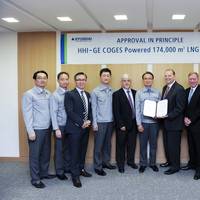
Hyundai Heavy Industries (HHI) announced it has jointly developed world’s first gas turbine-powered 174,000 m3 LNG carrier with GE Aviation and Marine and has secured Approval in Principle (AIP) on the vessel from the U.K.-based Lloyd’s Register. The IMO Tier III-compliant 174,000 m3 LNG carrier is equipped with GE’s gas turbine-based Combined Gas turbine Electric and Steam system (COGES 2.0). The vessel is expected to save shipowners or operators an estimated 20 billion Korean…
Rolls Royce Marine Awarded LCS Engine Repair Contract
U.S. Department of Defense informs that Rolls Royce Marine North America, Walpole, Massachusetts, is being awarded a US$9,000,000 firm-fixed-price repair order (N00104-09-G-A755) for the repair of one Marine Trent 30 marine gas turbine engine for the Littoral Combat Ship (LCS) Freedom variant. DoD explains that this contract provides for the repair and overhaul of the Marine Trent 30 marine gas turbine engine, replacement of non-repairable re-assembly to the LCS configuration, and pass-off testing to validate performance. Work will be performed in Bristol, United Kingdom, and is expected to be completed by February 2016. The Naval Sea Systems Command, Washington, District of Columbia, is the contracting activity.
DoD Awards $36-Million LCAC Contracts to L-3 Unidyne
Is a $22,231,067 firm-fixed-priced contract for the service life extension program (SLEP) for four landing craft, air-cushioned (LCAC) craft in fiscal 2014, 2015 and 2016. The LCAC SLEP will extend the service life from 20 to 30 years, sustain/enhance craft capability, replace obsolete electronics, repair corrosion damage, reduce life cycle cost by improving reliability and maintainability, increase survivability, and establish a common configuration baseline. The LCAC SLEP scope of effort includes repair and upgrade of the buoyancy box, gas turbine engine replacement, installation of a new skirt, installation of an integrated C4N equipment package, and accomplishment of selected craft alterations and repair work.
Bestobell’s Scores Chinese Contract

Bestobell Valves, part of the President Engineering Group, said it has received a major boost to its marine division with the award of a new contract for cryogenic cargo globe valves from the Hudong Zhonghua shipyard in China. The multimillion dollar contract will see the U.K.-based company manufacturing valves for six 174K LNG (Liquefied Natural Gas) Carriers. The LNGC have been contracted by Sinopec, China Shipping Group and MOL of Japan to ship coal bed LNG from the Gladstone field in Australia back to China.
Today in U.S. Naval History: December 12
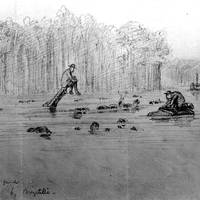
Today in U.S. 1862 - Confederate torpedo (mine) sinks USS Cairo in Yazoo River. 1937 - Japanese aircraft sink USS Panay in Yangtze River near Nanking, China. 1941 - Naval Air Transport Service is established. 1951 - First flight of helicopter with gas-turbine engine at Windsor Locks, Conn., demonstrates adaptability of this engine to helicopters. 1972- Captain Eugene A. Cernan, USN, commander of Apollo 17, walks on the Moon. Commander Ronald E. Evans, USN, was the Command Module Pilot. The mission lasted 12 days, 13 hours and 52 minutes.
Contamination Controlled
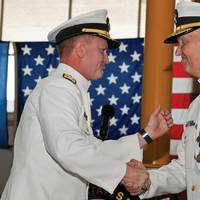
Rear Admiral Mark “Buz” Buzby, commander of the Military Sealift Command, sat with Maritime Reporter contributing editor Edward Lundquist talked with a week before his retirement aboard USNS Spearhead (JHSV 1) at Little Creek, Virginia, on May 10, 2013. The talk centered on a unique event in maritime history. MSC had seven ships in the area east of Japan, responding to the March 11, 2011 earthquake and tsunami that killed 19,000 people. One of them was the fast combat support ship USNS Bridge (T-AOE 10)…
Latest US Navy Contracts
The Department of Defense, has issued the following relevant Navy contracts. Teras BBC Ocean Navigation Enterprise Houston, LLC, Bellaire, Texas, is being awarded a $9,847,700 firm-fixed-price contract with reimbursable elements, for the worldwide charter of one U.S. flagged, self-sustaining, non-cellular containership. The containership will be employed in worldwide cargo delivery to support the U.S. Department of Defense. Work will be performed at sea worldwide and is expected to be completed by May 2014. The total cumulative face value of the contract is $47,281,490. Military Sealift Command, Washington, DC is the contracting activity.
US Navy Seeks to Transform Gas Turbine Technology
Naval Research Laboritory (NRL) scientists study the complex physics of Rotating Detonation Engines (RDE's). With its strong dependence on gas-turbine engines for propulsion, the U.S. Navy is always looking for ways to improve the fuel consumption of these engines. At the Naval Research Laboratory (NRL), scientists are studying the complex physics of Rotating Detonation Engines (RDEs) which offer the potential for high dollar savings by way of reduced fuel consumption in gas-turbine engines, explains Dr. Kazhikathra Kailasanath, who heads NRL's Laboratories for Computational Physics and Fluid Dynamics. Many Navy aircraft use gas-turbine engines for propulsion, with the Navy's gas-turbine engines being fundamentally similar to engines used in commercial airplanes.
U.S. Navy: The Business Case for a Titanium Ship

Participants at a workshop exploring the use of titanium structure for ships found that it is not only possible to construct a ship hull from titanium—or Ti, it could be cost effective. The workshop was sponsored by the Office of Naval Research and hosted by the University of New Orleans, where an ONR research program on titanium ship structures is being conducted. Representatives of the shipbuilding industry, titanium suppliers, Navy, Coast Guard and Air Force labs, and academia discussed and examined materials, processes and applications. Most ships today are primarily made from steel.
This Day in Naval History
For December 12th: 1862 - A Confederate torpedo (mine) sinks USS Cairo in the Yazoo River. 1937 - Japanese aircraft sink USS Panay (PR 5) in the Yangtze River near Nanking, China. 1941 - The Naval Air Transport Service is established. 1951 - The first flight of helicopter with a gas-turbine engine at Windsor Locks, Conn., demonstrates the adaptability of this engine to helicopters. 1972- Capt. Eugene A. Cernan, commander of Apollo 17, walks on the Moon. Cmdr. Ronald E. Evans was the command module pilot. The mission lasted 12 days, 13 hours and 52 minutes. HC-1 helicopters from USS Ticonderoga (CV 14) led the recovery. For more information about Naval history, visit the Naval Historical Center Web site at www.history.navy.mil.
Rolls-Royce MT30 Genset Achieves Full Power Ops with Navy
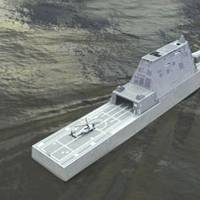
Rolls-Royce has achieved full power operation of its first production MT30 powered main turbine generator set delivered to the U.S. Navy. The MT30, delivered to the U.S. Navy for the DDG-1000, USS Zumwalt program, achieved full power operation at 36 MW during testing at the US Navy’s land based test site in Philadelphia, Pennsylvania. The selection by the US Navy for the DDG-1000 program marks the first large gas turbine engine ordered by the U.S. Navy for use in a generator set providing electrical power for propulsion and on-board systems throughout the ship.
Oceaneering Receives Naval Funding
Oceaneering International Inc., Chesapeake, Va., is being awarded an $11,984,265 firm-fixed-price contract for the Landing Craft Air Cushion (LCAC) service life extension program (SLEP) for the LCACs 30 and 56. The LCAC SLEP will extend the service life of LCAC from 20 to 30 years, sustain/enhance craft capability, replace obsolete electronics, repair corrosion damage, reduce life cycle cost by improving reliability and maintainability, increase survivability, and establish a common configuration baseline. The LCAC SLEP scope of effort includes repair and upgrade of the buoyancy box, gas turbine engine replacement, installation of a new skirt, installation of an integrated C4N equipment package, and accomplishment of selected craft alterations and repair work.
GE LM2500+G4 Earns Three Certifications
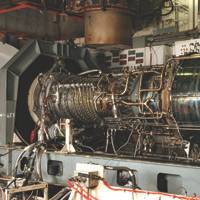
GE Marine reports it has completed a gas turbine engine qualification testing program for its LM2500+G4 marine aeroderivative gas turbines. As a result, the engine is now certified by three key organizations: Bureau Veritas, RINA S.p.A., and American Bureau of Shipping (Naval Vessel Rules). “To meet engine qualification requirements for the LM2500+G4, GE devised a rigorous testing program that was approved by all three key organizations,” said Brien Bolsinger, GE Marine general manager.
This Day in Naval History – Dec. 12
1862 - Confederate torpedo (mine) sinks USS Cairo in Yazoo River. 1937 - Japanese aircraft sink USS Panay in Yangtze River near Nanking, China. 1941 - Naval Air Transport Service is established. 1951 - First flight of helicopter with gas-turbine engine at Windsor Locks, CT, demonstrates adaptability of this engine to helicopters. 1972- Captain Eugene A. Cernan, USN, commander of Apollo 17, walks on the Moon. Commander Ronald E. Evans, USN, was the Command Module Pilot. The mission lasted 12 days, 13 hours and 52 minutes. Recovery by HC-1 helicopters from USS Ticonderoga (CVS-14). (Source: Nay News Service)
Freedom Tests New Gas Turbine Engines
Lockheed Martin and Marinette Marine Corp. Testing of the Rolls Royce MT-30 gas turbine engine is a significant step as the ship prepares for sea trials this summer. Freedom, the first of a new class of littoral combat ships, will use these two gas turbine engines and two main propulsion diesel engines to power the ship's steerable water jets, a first for a U.S. Navy ship, and propel the ship at speeds of more than 40 knots. "This was an important milestone," said LCS Program Manager Capt. Jim Murdoch. Freedom will continue to perform dock-side tests and evaluations as it prepares for its summer sea trials. The Navy expects to accept delivery of the ship and commission it later this year. LCS is a new breed of U.S.
Main Engine Lit Off Aboard Makin Island
Seven crew members from pre-commissioning unit (PCU) Makin Island (LHD 8) witnessed a construction milestone Feb. 26, when LHD 8 became the first Navy vessel with a 35,000 horsepower LM2500+ gas turbine engine to successfully complete forward main engine light off (MELO). LHD 8 is part of the Navy's Smart Ship design, which is an effort to reduce manpower through the increased use of technology. Makin is also the first amphibious assault ship equipped with a hybrid electric-drive propulsion system, a 4,160 volt electrical distribution system and an advanced machinery control system (MCS). Main Propulsion Leading Petty Officer, Gas Turbine Systems Technician…
This Day in Naval History - Dec. 12
From the Navy News Service 1862 - A Confederate torpedo (mine) sinks USS Cairo in the Yazoo River. 1937 - Japanese aircraft sink USS Panay (PR 5) in the Yangtze River near Nanking, China. 1941 - The Naval Air Transport Service is established. 1951 - The first flight of helicopter with a gas-turbine engine at Windsor Locks, Conn., demonstrates the adaptability of this engine to helicopters. 1972- Capt. Eugene A. Cernan, commander of Apollo 17, walks on the Moon. Cmdr. Ronald E. Evans was the command module pilot. The mission lasted 12 days, 13 hours and 52 minutes. HC-1 helicopters from USS Ticonderoga (CV 14) led the recovery.
This Day in Naval History - Dec. 12
1862 - A Confederate torpedo (mine) sinks USS Cairo in the Yazoo River. 1937 - Japanese aircraft sink USS Panay (PR 5) in the Yangtze River near Nanking, China. 1941 - The Naval Air Transport Service is established. 1951 - The first flight of helicopter with a gas-turbine engine at Windsor Locks, Conn., demonstrates the adaptability of this engine to helicopters. 1972- Capt. Eugene A. Cernan, commander of Apollo 17, walks on the Moon. Cmdr. Ronald E. Evans was the command module pilot. The mission lasted 12 days, 13 hours and 52 minutes. HC-1 helicopters from USS Ticonderoga (CV 14) led the recovery. For more information about Naval history, visit the Naval Historical Center Web site at www.history.navy.mil.
CAE's Marine Division Signs $19M in Deals
CAE signed new contracts to provide integrated bridge systems (IBSs) for the United Arab Emirates' Baynunah-class corvettes, and a land-based test facility for the German navy's F-124-class frigates. CAE also signed a contract amendment for the Indian navy's landing ship program and finalized the contract for the German navy's K130 corvette program. In total, the new agreements and contract amendment are worth about C$19 million, with an option of C$4 million for two additional Baynunah corvette IBSs. The new contract with the German navy calls for CAE to provide an F-124 land-based test facility to support CAE's integrated machinery control system (IMCS) already aboard the navy's new F-124 class frigates.
Rolls-Royce, Northrop Grumman And DCN To Produce New Marine Engine
Northrop Grumman Corp. and Rolls-Royce have signed an agreement with the French marine engineering company DCN to market and produce the WR-21 marine gas turbine engine. The business agreement, augmented by a license agreement between Northrop Grumman and DCN signed earlier this year, establishes a world-class team for the intercooled and recuperated WR-21. The WR-21 engine successfully completed the development phase of the U.S. Navy-, Royal Navy-, and French Navy-funded full-scale development program in February of this year. development, the engine accumulated approximately 2,100 fired test hours including a 500-hour endurance test in Pyestock, England, in 1998 and a 500-hour endurance test at the U.S. Navy's test facility in Philadelphia, Pa., in late 1999.










